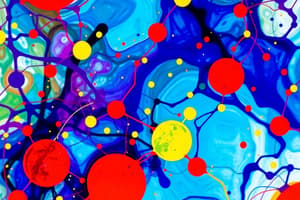Podcast
Questions and Answers
What type of molecule is cellulose classified as?
What type of molecule is cellulose classified as?
- Disaccharide
- Monosaccharide
- Polysaccharide (correct)
- Oligosaccharide
Which type of bonds hold parallel cellulose molecules together?
Which type of bonds hold parallel cellulose molecules together?
- Hydrogen bonds (correct)
- Ionic bonds
- Van der Waals forces
- Covalent bonds
What impact does cellulose have on human digestion?
What impact does cellulose have on human digestion?
- It provides significant energy
- It contributes to dietary fiber (correct)
- It is converted to glucose
- It is easily digested and absorbed
Which carbohydrate classification includes both simple sugars and double sugars?
Which carbohydrate classification includes both simple sugars and double sugars?
Which carbon atoms are involved in hydrogen bonding within cellulose molecules?
Which carbon atoms are involved in hydrogen bonding within cellulose molecules?
What is the primary function of carbohydrates in animals and plants?
What is the primary function of carbohydrates in animals and plants?
What is the primary role of cellulose in plants?
What is the primary role of cellulose in plants?
In carbohydrate classification, which of the following is an example of a polysaccharide?
In carbohydrate classification, which of the following is an example of a polysaccharide?
How does cellulose primarily function in plants?
How does cellulose primarily function in plants?
Which process involves the addition of water to break down polymers into monomers?
Which process involves the addition of water to break down polymers into monomers?
What type of bond is primarily responsible for the structure of carbohydrates like cellulose?
What type of bond is primarily responsible for the structure of carbohydrates like cellulose?
What is the general formula for carbohydrates, expressed as a ratio?
What is the general formula for carbohydrates, expressed as a ratio?
Which classification of monosaccharides consists of three carbon atoms?
Which classification of monosaccharides consists of three carbon atoms?
What is a common feature of all monosaccharides?
What is a common feature of all monosaccharides?
What characteristic type of isomerism involves compounds that are mirror images of each other?
What characteristic type of isomerism involves compounds that are mirror images of each other?
Which type of monosaccharide is characterized by having a six-carbon backbone?
Which type of monosaccharide is characterized by having a six-carbon backbone?
What is one primary function of monosaccharides in living organisms?
What is one primary function of monosaccharides in living organisms?
Monosaccharides can be used to form larger molecules. Which of the following is NOT a carbohydrate polymer?
Monosaccharides can be used to form larger molecules. Which of the following is NOT a carbohydrate polymer?
Which of the following properties is most commonly associated with monosaccharides?
Which of the following properties is most commonly associated with monosaccharides?
What is the main structural feature of aldoses when compared to ketoses?
What is the main structural feature of aldoses when compared to ketoses?
Flashcards are hidden until you start studying
Study Notes
Synthesis & Breakdown of Polymers
- Dehydration reaction connects monomers by removing a water molecule, forming a bond.
- Hydrolysis breaks polymers into monomers by adding a water molecule, creating an -OH group and an H atom at exposed sites.
Carbohydrates
- Composed of carbon, hydrogen, and oxygen in a 1:2:1 ratio, represented as (CH2O)n.
- Commonly sweet, water-soluble, and can crystallize, known as saccharides.
- Serve vital functions such as energy storage in plants and animals and contribute to cellular structure.
- Divided into three main classes: monosaccharides, disaccharides, and polysaccharides.
Monosaccharides
- Simplest carbohydrates, typically with 3 to 7 carbon atoms, often in 5 or 6-carbon backbones.
- Can combine to form polymers and can be converted into isomers or other organic molecules.
- Manifest in both linear and ring forms.
Properties of Monosaccharides
- Generally sweet, water-soluble, and capable of forming crystalline structures.
- Classified as reducing sugars, meaning they can act as reducing agents in reactions.
Function of Monosaccharides
- Primary energy source for respiration and serve as building blocks for more complex molecules.
Classification of Monosaccharides
- Classified based on carbon skeleton size and location of the carbonyl group:
- Triose sugars (C3H6O3)
- Pentose sugars (C5H10O5)
- Hexose sugars (C6H12O6)
Structural Isomerism
- Structural isomers possess the same molecular formula but vary in atomic arrangement.
- Geometrical isomers differ in spatial atomic arrangement and can exhibit optical isomerism (enantiomers), being mirror images of each other.
Examples of Monosaccharides
- Aldoses include glyceraldehyde, ribose, glucose, and galactose.
- Ketoses include dihydroxyacetone, ribulose, and fructose.
Cellulose Structure
- Composed of parallel cellulose molecules interlinked by hydrogen bonds between hydroxyl groups on carbon atoms 3 and 6, contributing to plant cell structure.
Studying That Suits You
Use AI to generate personalized quizzes and flashcards to suit your learning preferences.




